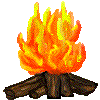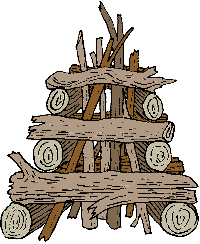|
|
|
 |
||||||||||||||||||||||||||||
| Home Page Campfire Index Campfire Songs Recipe Page |
||||||||||||||||||||||||||||
| Campfire Tips | ||||||||||||||||||||||||||||
| ALWAYS cover your fireplace as well as your woodpile at night - if it does rain you will find it much easier to get going in the morning. Hot ashes left in the grate will also help to keep dampness at bay, but make sure there are no embers as these could be fanned back into flames by the wind after everyone has gone to bed! | ||||||||||||||||||||||||||||
| Keep all orange peel and dry it (in the sun if possible). It burns extremely well and makes an excellent firelighter - just break into pieces (if it does not snap easily then it is not dry enough) and mix in with punk or paper, whatever you are using to start your fire. | ||||||||||||||||||||||||||||
 |
||||||||||||||||||||||||||||
| Once you have your fire lit, the girls will all immediately turn into pyromaniacs and be fascinated by the fire. Appoint an official fire-stoker and don't allow anyone else to put wood on, poke the fire etc. At all costs, resist the temptation to become Pyromaniac-in-chief!! | ||||||||||||||||||||||||||||
| Keep the water in your fire-bucket reasonably clean - besides dousing flames, it can be used to plunge burnt fingers in to prevent blistering (keep burns immersed for up to 10 minutes if necessary to completely cool tissues and reduce severity of scalds and burns.) | ||||||||||||||||||||||||||||
| In this day and age a lot of the girls will have no experience of open fires or matches - teach them to strike matches safely away from them; if possible, buy the extra-long matches - the girls are less likely to burn their fingers with them, and they burn for longer when trying to light a fire. | ||||||||||||||||||||||||||||
| You can make excellent fire-lighters using the fluff out of your tumble-dryer filter : this consists of mostly cotton fibres (check after you have dried your towels!) which burn well. Save dryer lint, cardboard egg-boxes (not polystyrene) and candle stubs - melt the candle stubs, mix with the lint and pour into the cells of the egg boxes. Leave to set; when needed, just break the boxes apart and use as firelighters - it is easy to light the card box with a match and this will in turn light the wax/lint mixture. | ||||||||||||||||||||||||||||
| The following should not be burnt on an open fire : polystyrene food trays, plastic bags of any kind, crisp packets, plastic bottles, yoghurt cartons, margarine tubs etc. - they all give off toxic fumes and acrid smoke. Egg shells (cooked or otherwise) - they will explode and hot bits will fly out of the fire |
||||||||||||||||||||||||||||
| Before beginning to lay a campfire (as opposed to a cooking fire) collect and sort your wood. It goes without saying that it needs to be as dry as possible - in wet weather, collect it beforehand and store in as dry a place as possible. Begin to construct your campfire by laying out a large square of logs or stones to contain any logs which should fall and roll towards the campers sitting round the fire. Within this "fireplace" lay down a large (3 foot/1 metre or more) square using the largest of your logs. Carry on building, laying two logs parallel across two opposite sides of your base square but slightly in from the edges, then two more at right angles on these to construct a second square (much as stacking wooden tent pegs to dry.) Carry on building with pairs of logs, decreasing the size of the square, to construct a hollow pyramid with a hole at the top - about 3 feet/ 1 metre high should give a really good long-lasting fire! THEN start to fill the hollow centre by inserting thinner logs and sticks down the middle - if your wood is damp, this is the point to add newspaper and firelighters wrapped in the newspaper. (and it might be a good idea even if your wood isn't damp!) Don't pack the centre too tightly - air must be able to get in. Have a bucket of water nearby as a fire-bucket and a pile of logs to one side, to replenish the fire should it prove necessary. When you are ready to light the fire, use a long stick : attach either a commercial firelighter, home-made firelighter or a cotton-wool ball, light this and insert carefully under the gap under the bottom layer of logs (there will be one if you have built the fire correctly!) - leave the lighter-stick in place once the fire catches hold. Keep an eye on the fire - it SHOULD fall inwards as it burns, but fires are always unpredictable, especially if there is any wind. This type of fire should produce excellent embers for cooking potatoes, apples etc. |
||||||||||||||||||||||||||||
 |
||||||||||||||||||||||||||||
| When organising a campfire, WRITE YOUR PROGRAMME DOWN so you don't dry up!! Include well-known favourites but also try to teach something new if you can - the "Repeat-after-me" type is a good idea. Make the programme varied - noisy songs with actions, quiet songs, rhymes and recitations. See if you can persuade one of the girls to lead a song or two to give your voice a break! | ||||||||||||||||||||||||||||
| "Camp-fire tales" can be fascinating - start by making up a story then stop at a crucial moment and pass on to the next girl : she has to add a bit more and then pass on to the next, and so on - it is amazing how convoluted the story can get! "Coffee-mate" milk powder will add a magical sparkle if scattered into the flames at the right point in the story, or you can use it as "wishing powder." | ||||||||||||||||||||||||||||